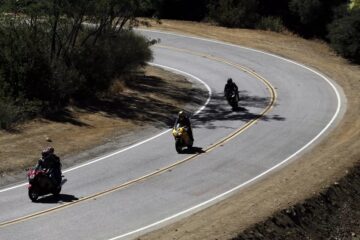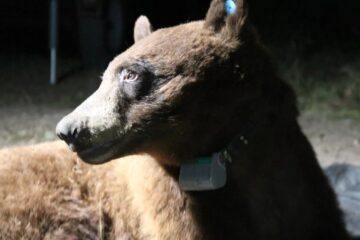Ed Lawrence: He branched out from this lone oak
Photographer Ed Lawrence noticed a solitary tree in the middle of an Albertson Ranch hayfield in 1962. One morning, he snapped the shutter — and the magnificent valley oak stood near the center of the resulting panorama. ‘That picture opened a lot of doors for me,’ says Lawrence, now 87.
Source of this article: The Los Angeles Times, November 29, 2011

Ed Lawrence holds a photograph he took in 1962 showing what was then called Albertson Ranch and is now Westlake Village. Included in the shot is a magnificent valley oak standing by itself in a field, center right. “That picture opened a lot of doors for me,” said Lawrence, now 87. (Mel Melcon, Los Angeles Times / November 16, 2011)
It wouldn’t be going out on a limb to say a solitary oak helped define Ed Lawrence’s life — and preserve the ranching history of Thousand Oaks and Westlake Village.
The 350-year-old valley oak was standing in the middle of an Albertson Ranch hayfield near the Los Angeles-Ventura county line when Lawrence first noticed it in March 1962.
Lawrence had wangled special permission to take a few pictures on the ranch, a working 12,000-acre cattle spread and movie locale that normally was closed to outsiders.
On a bright and blustery morning, he lugged his 4×5 view camera, its heavy-duty tripod and a bag of film holders up a ridge above the tree.
He spent three hours waiting for a line of clouds to drift behind the ranch. When they floated over the distant community of Agoura, he slipped a red filter over the front of his camera’s lens, shoved a black-and-white film holder into its back and tripped the shutter.
The picture turned out spectacularly. The clouds leaped out from the dark sky, and scattered oak trees dotted the ranchland as far as the eye could see. The magnificent lone oak stood near the center of the photo.
“That picture opened a lot of doors for me,” said Lawrence, now 87.
Ranch operators — who once had kicked a movie company off the property for cutting an oak’s limb — were thrilled when Lawrence presented them with a blowup of the oak photograph.
“They told me to come back to the ranch any time,” Lawrence said. “They gave me the combination to all the gate locks.”
Soon they were inviting him on cattle roundups when the animals were being moved to western movie sets. The ranch sometimes hosted as many as five film shoots a day.
When operators of the Janss family’s Conejo Ranch on the west side of Thousand Oaks saw the Albertson Ranch photos, they invited him as well.
Like the Albertson Ranch, which had been purchased by Los Angeles car dealer Fred Albertson from William Randolph Hearst in 1943, the Janss ranch was also heavily used for film and television production and was home to huge herds of sheep.
Lawrence became friends with Basque shepherds who worked there in the 1960s. They would tip him off when they sheared their flocks or herded them down streets in Thousand Oaks.
An avid hiker who worked as a photographer for Rocketdyne in Canoga Park and opened Thousand Oaks’ first camera shop, Lawrence continued documenting the area as the two ranches were subdivided into housing tracts. He returned to the ridge in 1966, 1970 and 1983 to photograph the development of Westlake Village.
He has photos of famous sets, such as the town used in the TV show “Gunsmoke.” But his favorite pictures include a striking portrait of an aging Basque shepherd named Juan Vasquez and images of shepherds moving sheep across the intersection of Thousand Oaks Boulevard and Moorpark Road in 1965.
In June, Thousand Oaks city officials, the Thousand Oaks Library Foundation, California Lutheran University and the Conejo Recreation and Park District acquired Lawrence’s collection for $75,000.
The collection came with an extra asset: Lawrence’s memory. At 87, he has returned to Thousand Oaks from his retirement home in Lake Tahoe to catalog and caption his photographs, which eventually will be digitized and made available to the public and for display.
In a backroom at the Thousand Oaks Library, Lawrence writes captions by hand for each of the images, such as a shot of ranch foreman Harlan Brown herding cattle through a tunnel beneath the Ventura Freeway.
“Ed’s amazing. He can remember all the names and dates the photos were taken,” said Jeanette Berard, who is in charge of the library’s special collections.
“But I can’t remember where I put my car keys this morning,” Lawrence said, laughing.
Lawrence said that when he snapped his photos, he was aware that development was inevitable. But city planners and developers “have kept the rural atmosphere — they’ve done a good job here,” he said.
One recent afternoon, Lawrence retraced his steps where two of his most iconic pictures were taken.
Traffic was so heavy that he almost couldn’t make it to the center divider at Thousand Oaks Boulevard and Moorpark Road, where he photographed the sheep in 1965.
He had better luck atop the ridge, knocking on Andrea Williams’ front door on Stoneshead Court.
“You’re Ed Lawrence, aren’t you?” she asked when she saw him holding his photoof the lone oak.
Her husband, Wayne Williams, invited Lawrence to use an upstairs balcony to get the best view of the spectacular valley he photographed in 1962. Houses, roads and a canopy of new trees now cover what had been the Albertson Ranch. The lone oak was nowhere to be seen, however.
It was cut down in a hurry Oct. 13 after an arborist warned that the diseased tree could fall into traffic lanes. It was replaced with a 25-foot coastal live oak.
Williams said she and her husband and their neighbors loved the landmark oak and revere the photo of it that Lawrence took nearly 50 years ago.
“We’re just so thrilled to meet you. You’re welcome here any time,” she said.
Once again, the photograph of the lone oak was opening doors for Ed Lawrence.


